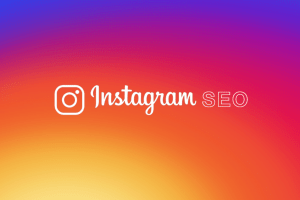Instagram SEO is the process of optimizing your content in order to rank your profile higher in the Instagram search results. And though it may not have the same appeal as live streams or carousel ads, it’s as worthy of your time as anything else. By following Instagram SEO best practices — which we’ll discuss shortly — you improve your chances of being discovered by users who are searching keywords related to your business.
Why is Instagram SEO important?
 It is important because it enables you to connect with people who are actively searching for content related to your business.
It is important because it enables you to connect with people who are actively searching for content related to your business.
Think of it this way: Each time a user types in a keyword that’s related to your business, you have an opportunity to make a positive impression and drive high-quality traffic to your profile (and your website). Instagram SEO is the key to capitalizing on these opportunities — the key to engaging prospective customers who are more likely than others to convert.
That’s all well and good, but there’s a crucial question we need to address: Do people actually use Instagram to interact with businesses in this fashion? Is it really worthwhile to optimize your content in order to rank higher in the search results?
Yes and yes. According to AdEspresso, more than 200 million Instagram users visit a business profile on a daily basis. 66% of those visits come from users who do not yet follow the profiles they’re visiting. Plus, 60% of all Instagram users say they’ve learned about new products through the platform.
Evidently, many people — your prospects included — see Instagram as a way to discover new businesses, new brands, and new products.
To be fair, searching for specific keywords is only one of several ways that users discover new businesses. Instagram ads drive discovery, and the Explore tab does, too. Instagram SEO, in other words, is not the be-all and end-all.
It is, however, the only way to organically connect with prospects who show an active interest in your content/business. Ads are not organic, and they do not connect you with proactive prospects. Discovery via the Explore tab is organic, but, again, there is no element of proactivity.
Now that we understand the value that Instagram SEO presents to marketers, here are four tips to help you successfully execute it at your company.
As we walk through these tips, keep in mind the ultimate goal: Getting your profile and individual posts to rank as high as possible for the keywords you care about.
1. Identify and prioritize your keywords
 Which keywords do you want to rank for? An answer to this question is absolutely necessary before you make a single change. Head terms (e.g., gardening) are searched frequently, and they typically indicate low commercial intent in the mind of the user. Long-tail keywords (e.g., gardening ideas) are searched infrequently, and they typically indicate high commercial intent in the mind of the user.
Which keywords do you want to rank for? An answer to this question is absolutely necessary before you make a single change. Head terms (e.g., gardening) are searched frequently, and they typically indicate low commercial intent in the mind of the user. Long-tail keywords (e.g., gardening ideas) are searched infrequently, and they typically indicate high commercial intent in the mind of the user.
Which is more important to you: increasing traffic to your profile, or driving more conversions? If it’s the former, you’re probably going to prioritize head terms over long-tail keywords. If it’s the latter, you’ll likely do the reverse.
You could argue that these two objectives go hand-in-hand— i.e., you want to increase traffic to your profile in order to drive more conversions. It’s a fair point, and most of you will end up optimizing your profile/content for both head terms and long-tail keywords. As we’ll discuss shortly, however, not all optimizations carry the same weight — and that’s why it’s important to establish your priorities from the jump.
2. Establish KPIs to measure impact
There’s one more question you need to answer before you start optimizing: How are you going to measure the impact of your Instagram SEO efforts? Measuring impact is an essential part of the process, as it enables you to determine which optimizations are (un)successful.
 To set yourself up for success, make sure to establish a few key performance indicators (KPIs). With Instagram Insights — the native analytics tool that comes with your business profile — you can track KPIs such as these (both at the profile level and the individual post level):
To set yourself up for success, make sure to establish a few key performance indicators (KPIs). With Instagram Insights — the native analytics tool that comes with your business profile — you can track KPIs such as these (both at the profile level and the individual post level):
- Impressions
- Reach
- Profile visits
- Followers
- Website clicks
- instagram-seo-metrics
- Via Social Media Examiner.
Once you know which KPIs you’re going to track, you’ll be able to measure the impact yielded by your optimizations.
3. Optimize your profile (username & bio)
 Now that you know (1) which keywords you’re going to target and (2) how you’re going to track your ROI, it’s time to optimize both your profile as a whole and your individual posts.
Now that you know (1) which keywords you’re going to target and (2) how you’re going to track your ROI, it’s time to optimize both your profile as a whole and your individual posts.
Let’s begin with your profile as a whole — we’re going to optimize your username and your bio. (Remember when we said not all optimizations carry the same weight? Well, your username and your bio are the heavy hitters; optimizing these two assets can make a huge impact). Your username is straightforward: You need to incorporate the keyword you consider most valuable. Clearly, the person who owns a profile wants to rank for the similar keywords
Optimizing your Instagram bio is equally straightforward: This is your opportunity to target any high-value keywords that didn’t quite make the cut for your username.
4. Optimize your individual posts (captions & hashtags)
- Use the main body of the caption to target a specific high-value keyword
- Use hashtags to reinforce that keyword and target ancillary keywords
Don’t neglect Instagram SEO!
Instagram SEO is a no-cost, high-impact tactic for anyone who wants to grow their reach, increase traffic to their profile/website, and drive more conversions. It may not yield the same volume of results as paid advertising, but the potential ROI is staggering. If you’re committed to using social media as an engine of growth for your business, Instagram SEO is a no-brainer.

